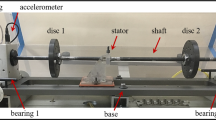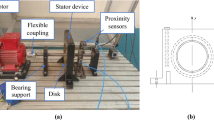Abstract
This paper proposes an improved transfer-matrix method (TMM) for investigating the steady-state response of complex rotor-bearing systems. The internal damping of the shafts is considered to enhance the accuracy of the method. A transfer matrix of ball bearings with clearance and Hertzian contact is established. In addition, the incremental harmonic balance method is combined with the TMM to obtain the steady-state response of the rotor systems and simplify the investigation processes. The simulation results verify the superiority of this method in programming, reducing the order of system matrix, and determining stability. Thus, this method is efficient in investigating the nonlinear dynamic characteristics of large-scale rotor-bearing systems.







Similar content being viewed by others
References
Daniel Maraini, C.: Nataraj: nonlinear analysis of a rotor-bearing system using describing functions. J. Sound Vib. 420(28), 227–241 (2018)
Kappaganthu, K., Nataraj, C.: Nonlinear modeling and analysis of a rolling element bearing with a clearance. Commun. Nonlinear Sci. Numer. Sim. 16(10), 4134–4145 (2011)
Kurvinen, E., Sopanen, J., Mikkola, A.: Ball bearing model performance on various sized rotors with and without centrifugal and gyroscopic forces. Mech. Mach. Theory 90(8), 240–260 (2015)
Hou, L., Chen, Y., Yiqiang, F., Chen, H., Zhenyong, L., Liu, Z.: Application of the HB–AFT method to the primary resonance analysis of a dual-rotor system. Nonlinear Dyn. 88(4), 1–21 (2017)
Bonello, P., Hai, P.M.: A receptance harmonic balance technique for the computation of the vibration of a whole aero-engine model with nonlinear bearings. J. Sound Vib. 324(1–2), 221–242 (2009)
Zhenyong, L., Hou, L., Chen, Y., Sun, C.: Nonlinear response analysis for a dual-rotor system with a breathing transverse crack in the hollow shaft. Nonlinear Dyn. 83(1–2), 169–185 (2016)
Sinou, J.-J.: Effects of a crack on the stability of a non-linear rotor system. Int. J. Non-linear Mech. 42(7), 959–972 (2007)
AL-Shudeifat, M.A., Butcher, E.A., Stern, C.R.: General harmonic balance solution of a cracked rotor-bearing-disk system for harmonic and sub-harmonic analysis: analytical and experimental approach. Int. J. Eng. Sci. 48(10), 921–935 (2010)
von Groll, G., Ewins, D.J.: The harmonic balance method with arc-length continuation in rotor/stator contact problems. J. Sound Vib. 241(2), 223–233 (2001)
Bai, C., Qingyu, X., Wang, J.: Effects of flexible support stiffness on the nonlinear dynamic characteristics and stability of a turbopump rotor system. Nonlinear Dyn. 64(3), 237–252 (2011)
Villa, C., Sinou, J.-J., Thouverez, F.: Stability and vibration analysis of a complex flexible rotor bearing system. Commun. Nonlinear Sci. Numer. Simul. 13(4), 804–821 (2008)
Sinou, J.-J.: Non-linear dynamics and contacts of an unbalanced flexible rotor supported on ball bearings. Mech. Mach. Theory 44(9), 1713–1732 (2009)
Sinou, J.-J., Didier, J., Faverjon, B.: Stochastic non-linear response of a flexible rotor with local non-linearities. Int. J. Non-linear Mech. 74(9), 92–99 (2015)
Zu-Qing, Q.: Model reduction for dynamical systems with local nonlinearities. AIAA J. 40(2), 327–333 (2002)
Nataraj, C., Nelson, H.D.: Periodic solutions in rotor dynamic systems with nonlinear supports: a general approach. J. Vib. Acoust. 111(2), 187–193 (1989)
Rouch, K.E., McMains, T.H., Stephenson, R.W., Emerick, M.F.: Modeling of complex rotor systems by combining rotor and substructure models. Finite Element Anal. Des. 10(1), 89–100 (1991)
Papadimitriou, C., Papadioti, D.-C.: Component mode synthesis techniques for finite element model updating. Comput. Struct. 126(15), 15–28 (2013)
Bathe, K.-J., Dong, J.: Component mode synthesis with subspace iterations for controlled accuracy of frequency and mode shape solutions. Comput. Struct. 139(15), 28–32 (2014)
Theodosiou, C., Sikelis, K., Natsiavas, S.: Periodic steady state response of large scale mechanical models with local nonlinearities. Int. J. Solids Struct. 46(20), 3565–3576 (2009)
Das, A.S., Dutt, J.K.: Reduced model of a rotor-shaft system using modified SEREP. Mech. Res. Commun. 35(6), 398–407 (2008)
Sun, C., Chen, Y., Hou, L.: Steady-state response characteristics of a dual-rotor system induced by rub-impact. Nonlinear Dyn. 86(1), 1–15 (2016)
Kuan, L., Zhenyong, L., Chen, Y.: Comparative study of two order reduction methods for high-dimensional rotor systems. Int. J. Non-linear Mech. 106(11), 330–334 (2018)
He, F., Dousti, S., Allaire, P., Dousti, M.: Squeeze film damper effect on vibration of an unbalanced flexible rotor using harmonic balance method. J. Eng. Sci. Technol. XX(Y(3)), 1–19 (2017)
David, J.W., Mitchell, L.D., Daws, J.W.: Using transfer matrices for parametric system forced response. J. Vib. Acoust. 109(4), 356–360 (1987)
Lee, A.-C., Kang, Y., Liu, S.-L.: Steady-state analysis of a rotor mounted on nonlinear bearings by the transfer matrix method. Int. J. Mech. Sci. 35(6), 479–490 (1993)
Liew, A., Feng, N.S., Hahn, E.J.: A non-linear transfer matrix technique for statically indeterminate rotor bearing systems. Proc. Inst. Mech. Eng. Part C-J. Mech. Eng. Sci. 215(11), 1343–1355 (2001)
Hsieh, S.-C., Chen, J.-H., Lee, A.-C.: A modified transfer matrix method for the coupling lateral and torsional vibrations of symmetric rotor-bearing systems. J. Sound Vib. 289(1–2), 294–333 (2006)
Cheung, Y.K., Chen, S.H., Lau, S.L.: Application of the incremental harmonic balance method to cubic non-linearity systems. J. Sound Vib. 140(2), 273–286 (1990)
Jin, Y., Yang, R., Hou, L., Chen, Y., Zhang, Z.: Experiments and numerical results for varying compliance vibrations in a rigid-rotor ball bearing system. J. Tribol. 139(4), 041103 (2017)
Yasuda, K., Torii, T., Kasahara, M.: Proposition of an incremental transfer matrix method for nonlinear vibration analysis. Trans. Jpn. Soc. Mech. Eng. C. 34(1), 12–18 (1991)
Zhang, Z., Chen, Y., Cao, Q.: Bifurcations and hysteresis of varying compliance vibrations in the primary parametric resonance for a ball bearing. J. Sound Vib. 350, 171–184 (2015)
Chen, G.: Vibration modeling and verifications for whole aero-engine. J. Sound Vib. 349(4), 163–176 (2015)
Vijayasree, N.K., Munjal, M.L.: On an integrated transfer matrix method for multiply connected mufflers. Journal of Sound and Vibration. 350, 171–184 (2015)
Parrinello, A., Ghiringhelli, G.L.: Transfer matrix representation for periodic planar media. J. Sound Vib. 317(9), 196–209 (2016)
Acknowledgement
This work was supported by the National Science Foundation of China [Grant Numbers 11872148, 11572082]; the Fundamental Research Funds for the Central Universities of China [Grant Numbers N170308028, N160312001]; and the Excellent Talents Support Program in Institutions of Higher Learning in Liaoning Province of China [Grant Number LJQ2015038].
Author information
Authors and Affiliations
Corresponding authors
Ethics declarations
Conflict of interest
The authors declare that they have no conflict of interest.
Additional information
Publisher's Note
Springer Nature remains neutral with regard to jurisdictional claims in published maps and institutional affiliations.
Appendix 1
Appendix 1
R and P in Sect. 2.2 can be expressed into Fourier series, as follows:
The state vector of the ball-bearing transfer matrix is presented as follows:
Rights and permissions
About this article
Cite this article
Luo, Z., Bian, Z., Zhu, Y. et al. An improved transfer-matrix method on steady-state response analysis of the complex rotor-bearing system. Nonlinear Dyn 102, 101–113 (2020). https://doi.org/10.1007/s11071-020-05952-5
Received:
Accepted:
Published:
Issue Date:
DOI: https://doi.org/10.1007/s11071-020-05952-5




